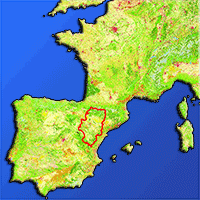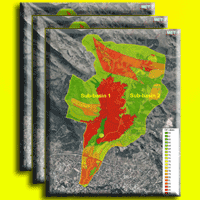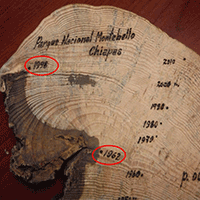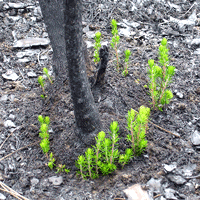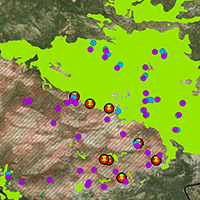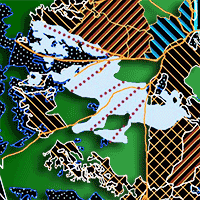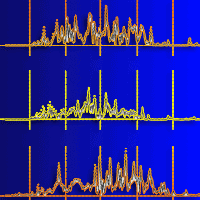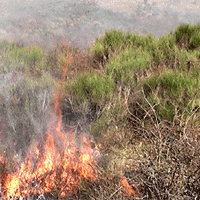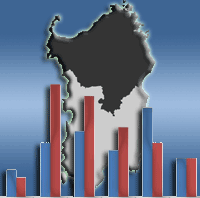
Large wildland fires and extreme temperatures in Sardinia (Italy)
Adrian Cardil (1) , Michele Salis (2-3), Donatella Spano (2-3), Giuseppe Delogu (4), Domingo Molina Terrén (1)
iForest - Biogeosciences and Forestry, Volume 7, Issue 3, Pages 162-169 (2014)
doi: https://doi.org/10.3832/ifor1090-007
Published: Feb 14, 2014 - Copyright © 2014 SISEF
Research Articles
Abstract
Heat-wave events are commonly recognized as adverse impacts on agriculture, forests, and economic activities. Several studies showed that future climate changes in the western Mediterranean Basin will lead to an increase in extreme weather events, mainly in the summer season. For this reason, it is crucial to improve our knowledge and investigate the effects of extreme temperature events on wildland fire activity. This work analyses the relation between high temperature days (air temperature higher than 25°C at 850hPa) and large wildland fires in Sardinia (Italy) during 1991-2009 period and the influence of high temperature days on large wildland fires was remarkable. The results showed that neither the number of fires nor the area burned decreased under high temperature days, although a decrease of both indicators was observed on the other days. Additionally, the average size of fires, the probability of large fire occurrence, the daily area burned and daily number of fires resulted higher in high temperature days.
Keywords
Authors’ Info
Authors’ address
Domingo Molina Terrén
School of Agrifood and Forestry Science and Engineering, University of Lleida, av.da Rovira Roure 191, E-25198 Lleida (Spain)
Donatella Spano
Department of Science for Nature and Environmental Resources (DIPNET), University of Sassari (Italy)
Donatella Spano
Euro Mediterranean Center on Climate Change (CMCC), IAFENT Division, Sassari (Italy)
Corpo Forestale e di Vigilanza Ambientale, Regione Sardegna, Cagliari (Italy)
Corresponding author
Paper Info
Citation
Cardil A, Salis M, Spano D, Delogu G, Molina Terrén D (2014). Large wildland fires and extreme temperatures in Sardinia (Italy). iForest 7: 162-169. - doi: 10.3832/ifor1090-007
Academic Editor
Raffaele Lafortezza
Paper history
Received: Jul 27, 2013
Accepted: Oct 21, 2013
First online: Feb 14, 2014
Publication Date: Jun 02, 2014
Publication Time: 3.87 months
Copyright Information
© SISEF - The Italian Society of Silviculture and Forest Ecology 2014
Open Access
This article is distributed under the terms of the Creative Commons Attribution-Non Commercial 4.0 International (https://creativecommons.org/licenses/by-nc/4.0/), which permits unrestricted use, distribution, and reproduction in any medium, provided you give appropriate credit to the original author(s) and the source, provide a link to the Creative Commons license, and indicate if changes were made.
Web Metrics
Breakdown by View Type
Article Usage
Total Article Views: 59509
(from publication date up to now)
Breakdown by View Type
HTML Page Views: 48316
Abstract Page Views: 4750
PDF Downloads: 4747
Citation/Reference Downloads: 57
XML Downloads: 1639
Web Metrics
Days since publication: 4323
Overall contacts: 59509
Avg. contacts per week: 96.36
Citation Metrics
Article Citations
Article citations are based on data periodically collected from the Clarivate Web of Science web site
(last update: Mar 2025)
Total number of cites (since 2014): 41
Average cites per year: 3.42
Publication Metrics
by Dimensions ©
Articles citing this article
List of the papers citing this article based on CrossRef Cited-by.
References
Application of wildfire simulation models for risk analysis. Geophysical Research Abstracts 11: EGU2009-5489.
Gscholar
Potential changes in fire probability and severity under climate change scenarios in Mediterranean areas. In: “Modelling Fire Behaviour and Risk” (Spano D, Bacciu V, Salis M, Sirca C eds). NuovaStampacolor, Sassari, Italy, pp. 92-98.
Gscholar
Detailed downscaling through ensemble techniques of the regional climate models for a fire weather indices projection in the Alpine region. In: “Modelling Fire Behaviour and Risk” (Spano D, Bacciu V, Salis M, Sirca C eds). NuovaStampacolor, Sassari, Italy, pp. 85-91.
Gscholar
Il clima della Sardegna. In: “Collana Note Tecniche di Agrometeorologia per la Sardegna”. (Milella A ed). Sassari, Italy, pp. 17-38. [in Italian]
Gscholar
A comparaison of fire probability maps derived from GIS modeling and direct simulation technique. In: Proceedings the Joint Fire Science Conference and Workshop “Crossing the Millennium: Integrating Spatial Technologies and Ecological Principles for a New Age in Fire Management” (Neuenschwander LF, Ryan KC, Gollberg GE, Greer JD eds). Boise (Idaho - USA), 15-17 June 1999. University of Idaho, Moscow, ID, USA, pp. 130-137.
Gscholar
The NCEP/NCAR 40-year reanalysis project. Bulletin of the American Meteorology Society 77: 437-471.
CrossRef | Gscholar
A re-examination of the synoptic and mesoscale meteorology of Ash Wednesday 1983. Australian Meteorological Magazine 54: 35-55.
Gscholar
Improving fire management success through fire behaviour specialists. Research Report 23, European Forest Institute, Joensuu, Finland, pp. 105-119.
Gscholar
Situaciones sinópticas relacionadas con el inicio de grandes incendios forestales en Cataluña. NIMBUS 1-2: 93-112. [in Spanish]
Gscholar
Impactos sobre los riesgos naturales. Riesgo de incendios forestales. In: “Evaluación preliminar de los impactos en España por Efecto del Cambio climático”. Spanish Ministry of Environment, Madrid, Spain, pp. 581-615. [in Spanish]
Gscholar
The summer Northern annular mode and abnormal summer weather in 2003. Geophysical Research Letters 32: L04706.
Gscholar
Introduction to wildland fire (2nd edn). John Wiley and Sons, New York, USA, pp. 769.
Gscholar
Adapting to global change: Mediterranean forests. IUCN Centre for Mediterranean Cooperation, Malaga, Spain, pp. 254.
Gscholar
Extreme wildfire spread and behavior: a case study from North Sardinia. In: “Modelling Fire Behaviour and Risk” (Spano D, Bacciu V, Salis M, Sirca C eds). NuovaStampacolor, Sassari, Italy, pp. 138-144.
Gscholar
Large forest fires in Canada, 1959-1997. J Geophys Res Atmos 108: 5-12.
Gscholar
The science and opportunity of wildfire risk assessment (chapt. 6). In: “Novel Approaches and Their Applications in Risk Assessment” (Luo Y ed). Intech, Shangai, China, pp. 99-120.
Gscholar
How exceptional was the early August 2003 heatwave in France? Geophysical Research Letters 32: L10701.
Gscholar

